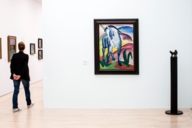
The artist group “Blauer Reiter” or "Blue Rider" formed in Munich at the turn of the century. Its members are considered to be among the most significant representatives of the avant-garde movement that took hold at the beginning of the 20th century. Its artwork broke with many different conventions. And it was not always on the receiving end of applause.
The Blauer Reiter embarked on a entirely new artistic path: away from the confines of lifelike depiction and towards a description of the artist's inner experience. The painters, who themselves felt connected to this new dawn of artistic expression and who went on to exhibit their increasingly abstract images – first in Munich and later throughout Europe – were August Macke, Gabriele Münter, Franz Marc, Marianne von Werefkin, Alexei Jawlensky, Alfred Kubin, Paul Klee, the composer and painter Arnold Schönberg, Heinrich Campendonk and Robert Delaunay. Munich’s Lenbachhaus is home to the world's largest collection of Blauer Reiter art.
Munich attracted artists from all over the world as it had established itself as a Mecca for art at the turn of the century. The members of the Blauer Reiter group originally made their acquaintance at the numerous painting schools, studios and salons in Schwabing and Maxvorstadt district, such as the two painters Jawlensky and Werefkin or Kandinsky and Münter; it was also here that Kandinsky and Marc went on to become friends, and it was also that Macke and Klee eventually became part of the group.
During joint excursions and shared visits, they discovered the landscape around Murnau and the Bavarian Alpine foothills for themselves. Kandinsky and Münter moved into a villa in Murnau, where Münter lived until she died in 1962, and which is still open to visitors today.
The rural area was a source of never-ending inspiration to the painters, who went on to develop their very own form of expression. The name Blauer Reiter was also forged during one of the group’s many stays in the Oberland region. Kandinsky's notes contain the following entry: "We invented the Blaue Reiter while sat at the coffee table in the garden gazebo in Sindelsdorf; both of us loved blue. For Franz Marc, it was the horses, for me the riders. And that is how the name came to be. (...). “
The two exhibitions by the Blue Rider group in Munich in the years 1911 and 1912 were by no means popular successes. At that time, visitors had only a minimal understanding of Kandinsky's improvisation work, or Marc's colourful animal figures. And upon the outbreak of the First World War, the group broke up: Macke and Mark both died at the Front, while Kandinsky was forced to return to his homeland as a Russian citizen.
It is all thanks to Gabriele Münter that many of the images from this exciting artistic period managed to survive: testimonies if you will to Classical Modernism that still exist to this day. In 1957, and to mark her 80th birthday, she dedicated her own pictures and those of her artist friends to the Städtische Galerie (art gallery) in Lenbachhaus, totalling more than 1,000 works. Among these artistic gems were numerous paintings by Kandinsky that she had saved from destruction during the Second World War. In 1965, another donation was made in the form of paintings by Macke and Marc.
Aside from those on display at Lenbachhaus, works of art by the Baue Reiter group can also be enjoyed near Munich at the Schlossmuseum Murnau, the Franz Marc Museum in Kochel am See and at the Museum Penzberg.